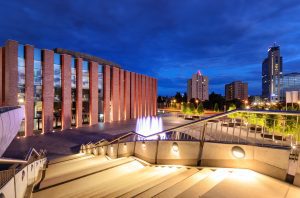In the past 10 years, the data center industry transformed itself. We’ve gone from first hearing the term cloud computing to talking about edge computing and driverless cars in a little more than a decade. The progress and performance made have been tremendous. And it really got us thinking. What if we compared the performance of the data centers back then with today’s data centers to see how they’re performing and to determine what progress we’ve made as an industry?
So, we modeled three step function examples that have made a significant impact — UPS improvements, containment, and economization — and our model showed about an 80 percent reduction in losses just using those three technologies. We have increased physical infrastructure efficiency by about 80 percent by providing more efficient architectures and more efficient products.
And this finding prompted this question: What will drive the next 80 percent of data center improvements in the next 10 years?

We know that if we stay on the current path with our current strategies, which have been very effective, we’re probably approaching the point of diminishing returns. So, with a focus on the future and in advance of my May 1 talk at the Data Center Dynamics Enterprise event in New York, I want to share some of our thoughts on technologies and areas we’re researching to find ‘the next 80 percent’ improvement.
So, here we go:
Current solutions are not flexible enough.
Micro data centers and prefabricated models by definition will come packaged with best practice designs. But what about more traditional deployments? Containment should be made easier to deploy, particularly for colocation providers. We believe the answer lies in rack-ready systems that enable efficiency and minimize the disruption of construction. The industry can do better here and we think our HyperPod is a good first step.
Liquid cooling may finally happen….
If we look at overall energy consumption, rising densities at the chip level are arguably becoming the limiting factor in IT design. It’s possible that a renaissance is coming and liquid cooling may be the wave of the future. There are still many barriers we need to address but it seems more likely to happen now than ever before.
The data center of the future will have more interaction with the grid and IT.
With renewables on the rise, the decreased cost of energy storage, and greater variability of IT loads, we see opportunities to more fully utilize resources, improve resiliency, minimize energy consumption, and reduce carbon footprint. But we need to start thinking in broader terms. Energy storage systems, software defined power, and microgrids are examples where growth may achieve these performance goals.
Renewables and IT load variability, plus more sophisticated cooling architectures mean much more complexity.
In this very complex hybrid environment, we see cloud-based management systems as the answer. Software, like our EcoStruxure platform, and analytic tools will allow for predictive capabilities and higher performance. The future of data centers is about connecting, collecting, analyzing and taking action.
I’m looking forward to discussing how we might accomplish all of this in the most efficient ways possible at Data Center Dynamics Enterprise on May 1. I will also be in New York on April 30 for DCD Focus Day – Building the Edge where I’ll share lessons from the retail edge, with an emphasis on how technology is changing the store experience and redefining mission critical.




Conversation
Thank you, Kevin, for such an interesting read. There is not even an iota of doubt in the fact that there is still a lot to achieve when it comes to IT technologies.
Thanks for the comment Roxanne – glad you enjoyed the blog.